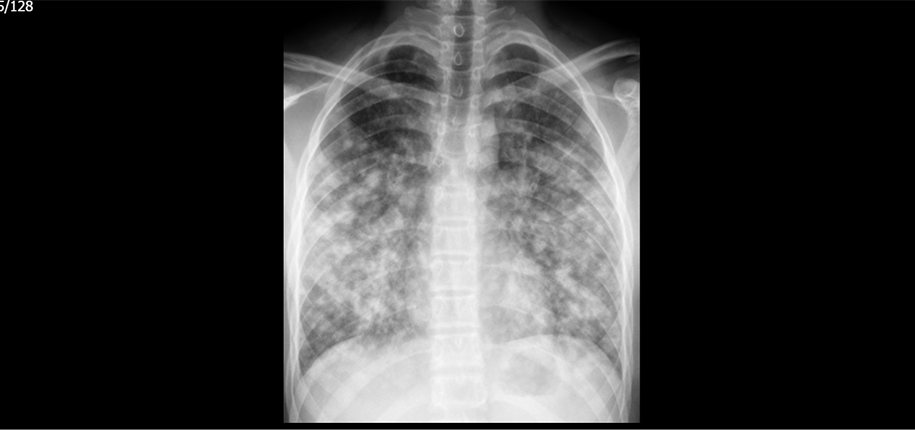
The WOPR is the Wise Old Professor of Radiology. He’s a more-or-less retired radiologist who has taught me a
I’m a pediatric radiologist here at Children’s, and I recently had a chance to teach one of my teachers about pneumonia in children after his first granddaughter was diagnosed with pneumonia a few weeks ago. I call him the Wise Old Professor of Radiology (the WOPR). He’s a more-or-less retired adult chest radiologist who still comes to work at the adult hospital across the street. He has taught me a lot about both medical knowledge and caring for people.
“Craziest thing I’ve ever seen,” said the WOPR. “My daughter-in-law took my granddaughter Ella to the pediatrician because she had a fever and was coughing. Without even doing a chest X-ray, the pediatrician decided that she had pneumonia and put her on antibiotics. Who ever heard of diagnosing pneumonia without getting a chest X-ray?”
“Well,” I said, “children are different. They’re not little adults.” This is a favorite saying of pediatricians. It’s often a good reminder, especially when talking to medical people who usually work with adults.
In adults when we say pneumonia, we usually mean pneumonia caused by a bacterial infection. Bacterial pneumonias are more common than viral pneumonia in adults, they’re usually more serious, and they’re the ones that can be treated with antibiotics. Antibiotics don’t help with viral pneumonia.
In adults, a chest X-ray with abnormal airspaces is usually due to a bacterial pneumonia. It’s harder in children. In children’s airways, the tubes that air moves through in the lungs are smaller, and when they get inflamed, they swell more and they make more mucus than the airways in adults do. All those things make it more likely that one of the airways in a child’s lung will get blocked. When that happens, the air spaces in the lung beyond that airway will collapse, and that can show up on a chest X-ray and look like pneumonia.
Another difference is that viral pneumonia is much more common than bacterial pneumonia in young children. There are articles that say you can do a better job telling whether a pediatric pneumonia is bacterial or viral from the age of the patient than from what the chest X-ray looks like.
“WOPR,” I said, “this is one of those areas that needs clinical experience and judgement more than a test. I don’t see a problem with the pediatrician examining your granddaughter and deciding that she has pneumonia, that she’s not sick enough to need to go to the hospital, but that she is sick enough so that the pediatrician thinks it’s a good idea to prescribe antibiotics, even though bacterial pneumonia is unlikely. There are a lot of places in pediatrics where the most important test is whether or not an experienced pediatrician thinks that the patient is seriously ill.”
“OK,” said the WOPR, “but why did she wait a week and then get a chest X-ray? Seems to me he should have just gotten one right away.”
“WOPR, you know better than that. A chest X-ray tells you what’s going on when you get it, not what was going on before or what will happen afterwards. What was going on when she got the chest X-ray?”
“Ella was still coughing; that’s why we brought her back to the pediatrician. Her fever was gone and she was acting better, but we were all worried that she hadn’t stopped coughing.”
“Sounds to me like the system worked just the way it should. Ella’s pediatrician diagnosed and treated her for pneumonia. Her mom listened to the pediatrician who said to bring her back if she wasn’t better in a week. When her pediatrician saw that she was still coughing, she got a chest X-ray to make sure that there wasn’t anything to suggest a worsening pneumonia or some other cause for her cough. How’s she doing?”
“Great,” said the WOPR. “The cough stopped a few days later and now she’s 100% great!”
At this point I had to take a break to look at about a dozen pictures that showed what a 100% great Ella looks like.
“WOPR, two more things. First, I don’t want anyone to think that it’s a mistake to get a chest X-ray right away for pneumonia. There are clues to what’s going on that can be useful. Sometimes the chest X-ray looks much worse than we thought it would, and sometimes much better. In both those cases it could change how we take care of the child. There are lots of things that can make it hard to breath besides pneumonia, and a chest X-ray can be a good way to make sure that none of those are going on. It’s a judgement call.”
“The second thing is that when an adult has pneumonia, we get a follow-up chest X-ray in about six weeks to make sure the pneumonia has cleared up completely. That’s because pneumonia that doesn’t clear up can be a sign of lung cancer, and we need to make sure that’s not what’s going on. Children don’t get lung cancer, thank goodness, and if they get better clinically, we don’t need to do follow-up chest X-rays.”
Dr. Alan Brody, author; Glenn Miñano, BFA, editor; Meredith Towbin, copy editor